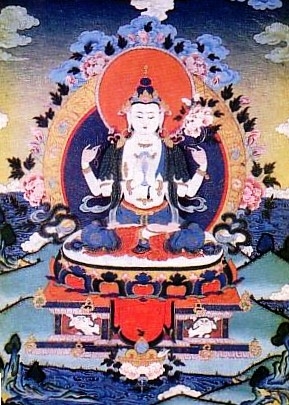Mani mantra: Difference between revisions
Jump to navigation
Jump to search
mNo edit summary |
(ཧཱུྂ༔ !) |
||
| Line 1: | Line 1: | ||
[[Image:Avalokiteshvara.JPG|frame|[[Avalokiteshvara]] thangka, courtesy of Lama Tsondru Sangpo]] | [[Image:Avalokiteshvara.JPG|frame|[[Avalokiteshvara]] thangka, courtesy of Lama Tsondru Sangpo]] | ||
The '''Mani mantra''' is the six syllable mantra of [[Avalokiteshvara]]: '''oṃ mani padme hūṃ''' (Skt.; Tib. | The '''Mani mantra''' is the six syllable mantra of [[Avalokiteshvara]]: '''oṃ mani padme hūṃ''' (Skt.; Tib. ཨོཾ་མ་ཎི་པདྨེ་ཧཱུྂ༔, ''om mani pémé hung'', [[Wyl.]] ''oM ma Ni pad+me hU~M`:''). In the [[terma]] tradition, Avalokiteshvara's seed syllable '''hrīḥ''' is added to the end of the mantra, making seven syllables. | ||
==Benefits of the Mani Mantra== | ==Benefits of the Mani Mantra== | ||
Revision as of 22:51, 8 June 2018

The Mani mantra is the six syllable mantra of Avalokiteshvara: oṃ mani padme hūṃ (Skt.; Tib. ཨོཾ་མ་ཎི་པདྨེ་ཧཱུྂ༔, om mani pémé hung, Wyl. oM ma Ni pad+me hU~M`:). In the terma tradition, Avalokiteshvara's seed syllable hrīḥ is added to the end of the mantra, making seven syllables.
Benefits of the Mani Mantra
It is said:
- Reciting oṃ mani padme hūṃ one hundred or one thousand times is of equal merit to reciting the whole of the Kangyur.
- Reciting oṃ mani padme hūṃ ten thousand times closes the door to rebirth in the lower realms.
- Reciting oṃ mani padme hūṃ one million times one will reach the level of an irreversible bodhisattva.
- Reciting oṃ mani padme hūṃ ten million times one will attain perfect buddhahood.
Further Reading
- Sogyal Rinpoche, The Tibetan Book of Living and Dying, Appendix Four, pages 396-398.